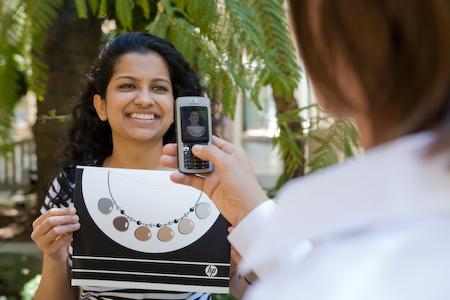HP unveils mobile beauty innovation
HP is hoping to partner with global cosmetics firms to move its innovative mobile 'foundation colour matching' service from theory to reality.


HP has created an innovative system that blends the world of cosmetics and mobile technology, which it hopes to trial in the next six months.
The computing giant was approached by one of its customers - a large consumer packaged goods (CPG) company, which wanted it to create something technically advantageous to help it engage better with its 80 per cen female audience, according to Nina Bhatti, principal scientist in the digital imaging and printing lab at HP's Labs.
The result is a colour-matching platform for mobile phone images, which makes use of the company's imaging and mobility expertise.
"We're talking about an unusual juxtaposition of things. You don't usually associate HP with cosmetics or the retail mobile experience but that's what we've built here," she said.
"[The customer in question had] done lots things before like in-store kiosks but that is very expensive. We wanted to do something mobile and futuristic and realised that our target group was teenage girls as that's often the first time they experiment cosmetics. If you go to a very expensive department store there are women to assist you but they're often very domineering and might intimidate you into buying more products. Those women are just looking at your face but what if your phone could look at your face?"
Many women often buy the wrong shade of foundation because they match their assess their skin tone based on the colour of their hands (often a darker shade than the face) or don't realise that the product may look different when it dries so they usually find the experience a disappointing one and end up with a draw of unwanted cosmetic items, according to Bhatti.
The idea behind HP's concept is for a woman to take a picture of herself - or get someone else to do so - whilst holding a colour chart (one provided by HP that would be obtained in store or as a magazine pull out) and then send it via MMS to HP's systems which analyse the sender's skin tone and send back a message with a suggest shade of foundation.
Get the ITPro daily newsletter
Sign up today and you will receive a free copy of our Future Focus 2025 report - the leading guidance on AI, cybersecurity and other IT challenges as per 700+ senior executives
The technology detects which part of the photo is the woman's face by using an enhanced Viola and Jones method, a face mask template is applied and then pixels with luminance outside bounds are excluded.
"We wanted to take a [mobile] phone and really view the device in a different way. Half the phones shipped are shipped with a camera. This is a networked camera that girls have in their handbag or pocket all the time," added Bhatti.
HP has thus far analysed the skin of 260 women as part of its exercise but it wants to now move the project forward into commercial reality.
"The current status is the system is now running as a networked live service in prototype and entails five product lines," Bhatti said.
"We plan on doing consumer testing on this as we want to know how women feel about it and we are looking for partnerships with cosmetics companies to run those trials and create revenue-generating services."
HP also believes that its mobile innovation has potential uses outside of the beauty industry, for example in healthcare.
Maggie has been a journalist since 1999, starting her career as an editorial assistant on then-weekly magazine Computing, before working her way up to senior reporter level. In 2006, just weeks before ITPro was launched, Maggie joined Dennis Publishing as a reporter. Having worked her way up to editor of ITPro, she was appointed group editor of CloudPro and ITPro in April 2012. She became the editorial director and took responsibility for ChannelPro, in 2016.
Her areas of particular interest, aside from cloud, include management and C-level issues, the business value of technology, green and environmental issues and careers to name but a few.
-
 Meta just revived plans to train AI models using European user data
Meta just revived plans to train AI models using European user dataNews Meta has confirmed plans to train AI models using European users’ public content and conversations with its Meta AI chatbot.
By Nicole Kobie
-
 AI is helping bad bots take over the internet
AI is helping bad bots take over the internetNews Automated bot traffic has surpassed human activity for the first time in a decade, according to Imperva
By Bobby Hellard